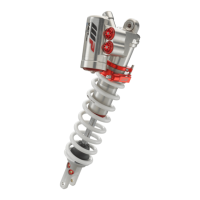9 TUNING THE CHASSIS
14
9.1 Checking the basic chassis setting with rider's weight
401030-01
– For optimal motorcycle riding characteristics and to avoid
damage to forks, shock absorbers, link fork and frame, the
basic settings of the suspension components must match the
rider's weight.
– This chassis component is factory set to a standard rider's
weight.
Guideline
Standard rider weight 75 … 85 kg (165 … 187 lb.)
– If the rider's weight is above or below this range, the basic
setting of the suspension components must be adjusted
accordingly.
– Small weight differences can be compensated by adjust-
ing the spring preload, but in the case of large weight differ-
ences, the springs must be replaced.
9.2 Compression damping of the shock absorber
The compression damping of the shock absorber is divided into two ranges: high-speed and low-speed.
High-speed and low-speed refer to the compression speed of the rear wheel suspension and not to the vehicle
speed.
The high-speed setting, for example, has an effect on the landing after a jump: the rear wheel suspension com-
presses quickly.
The low-speed setting, for example, has an effect when riding over long ground swells: the rear wheel suspen-
sion compresses slowly.
These two ranges can be adjusted separately, although the transition between high-speed and low-speed is
gradual. Thus, modifications in the high-speed range affect the compression damping in the low-speed range
and vice versa.
9.3 Shock absorber rebound damping
The rebound damping of the shock absorber is divided into two ranges: high-speed and low-speed.
High-speed and low-speed refer to the rebound suspension speed of the rear wheel and not to the vehicle
speed.
The high-speed setting affects, for example, the rebound of the rear wheel after a jump and the traction when
the rear wheel rebounds quickly.
The low-speed setting affects the overall vehicle balance.
These two ranges can be adjusted separately, although the transition between high-speed and low-speed is
gradual. Consequently, modifications in the high-speed range affect the rebound in the low-speed range and
vice versa.

